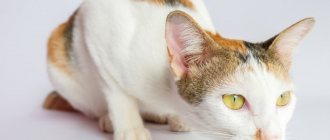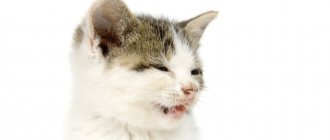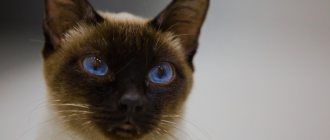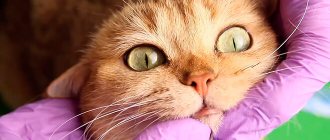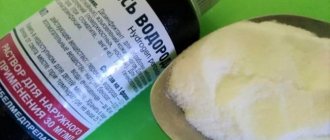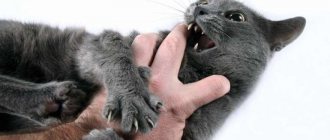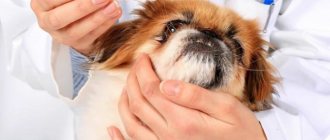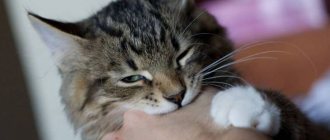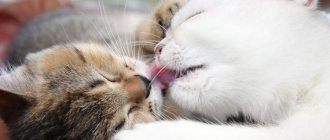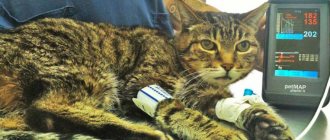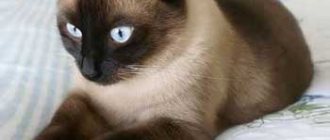You can hear sneezing not only from people, but also from pets. Our mustachioed-striped pets often sneeze when they climb into a dusty corner and dust gets into their nose, but if this happens constantly, the cat’s nose and eyes are running, he coughs, then the problem is clearly not simple and requires the intervention of specialists.
What to do if your cat sneezes? What caused it? It is these questions that we will try to answer in this material.
How to treat a cat
Before you begin treating your cat, you should find out the cause of the sneezing. A visit to the veterinary clinic, a visual examination and tests will help you choose the right therapy.
The owner is required to:
- strictly follow the doctor’s recommendations,
- give your cat medications on time,
- Regularly treat (rinse, instill) the nose of a sick animal.
On a note! During therapy, the animal's diet should be changed. A runny nose negatively affects a cat's sense of smell, and poor sense of smell negatively affects digestion. During illness, it is worth choosing food with a pronounced aroma.
When to see a doctor
A sick animal should definitely be seen by a veterinarian if, in addition to sneezing, the following are present:
- tearfulness, purulent discharge from the eyes;
- lack of air;
- coughing;
- pus, ichor from the nose;
- loss of appetite;
- restless rubbing of the nose with a paw, as if something is disturbing;
- wheezing;
- chills;
- hyperthermia;
- dry crusts near the nostrils;
- diarrhea;
It is difficult to figure out on your own the reason why your pet often sneezes. It is better to entrust your pet to a doctor, he will make an accurate diagnosis and prescribe adequate treatment.
Treatment of a runny nose in a cat with medications
When a runny nose is diagnosed, the animal is treated according to the following scheme:
- prescribing antipyretic drugs for fever,
- the use of drops, solutions to facilitate breathing,
- prescribing expectorants for coughs,
- taking vitamins to strengthen the immune system,
- prescribing antibiotics for complications.
Be sure to read:
The cat does not drink water: reasons, daily intake, what to do, is it dangerous, how to force the animal to drink
Commonly prescribed medications:
- Intranasal drops "Anandin" - stimulate the immune system.
- Naphthyzin nasal spray - used to rinse the nasal passages.
- Xylometazoline nasal drops make breathing easier.
The correct dosage is prescribed by the doctor.
How to find out why your cat has a runny nose?
At the veterinary clinic, the doctor will tell you the causes of the disease and prescribe treatment after a series of measures:
- Examination of a sick animal, which includes: examination of the mouth and throat, measuring temperature, palpating the lymph nodes and abdomen of the cat.
- Studying the history of the disease from the owner’s words: when the cat got sick, how the illness began, how many days it has been sick, how it behaves, etc.
- Conducting general and biochemical blood tests and urine tests.
- If necessary, your doctor may recommend a swab of your cat's nose or throat.
- If the veterinarian suspects the presence of polyps or a malignant neoplasm in the nose, an endoscopy of the nasal passages or an X-ray of the head will be necessary for an accurate diagnosis.
After all the results are received, the veterinarian will give an exact answer to the question: “Why is the cat sneezing and his eyes watering?”
Traditional methods of treating a runny nose
At home, runny nose in cats is treated using folk remedies.
To rinse the nasal sinuses use:
- weak salt solution (20 grams of sea salt per glass of boiled water),
- soda solution (half a teaspoon per 200 ml of liquid),
- furatsilin,
- boric acid solution (a pinch per glass of boiled water).
For treatment, instillation is used:
- beet juice (1 drops of freshly squeezed juice per tablespoon of water),
- aloe leaf juice (one drop in each nasal passage 3 times a day).
Inhalations based on fir and eucalyptus oils will help your cat. Pour hot water into the container, add 3-4 drops of medicinal oil, hold the animal near the container for 5-10 minutes.
Dangerous causes requiring special attention
- Viral, infectious and fungal diseases . Leukemia, immunodeficiency, rhinotracheitis, calicivirus and other dangerous diseases include sneezing in the list of symptoms. These diseases are fatal without timely diagnosis and treatment. At risk are kittens, pregnant and elderly animals, as well as animals picked up from the street or taken from shelters. It is important to understand that vaccination also does not provide 100% protection against infection and these diseases cannot be ruled out even in vaccinated pets!
- Tumors and polyps . If you notice that your pet has constant nasal congestion, sneezing and a runny nose, then one of the reasons may be a new growth in the nasal passage. To diagnose such a problem, you need to go to the clinic for an examination. Most likely, a rhinoscopy (using an endoscope) will be required to remove this tumor.
- Asthma . If, in addition to sneezing, your pet experiences wheezing, shortness of breath, or coughing, this may be a manifestation of asthma. In this case, you should contact the clinic for a more accurate diagnosis and prescription of medications.
- Dental problems . Often sneezing occurs due to dental problems. At the same time, the pet rubs its mouth and nose with its paws, and it often has difficulty eating. Examine your cat's oral cavity: if you notice plaque on the teeth, redness of the gums, an unpleasant odor, or drooling, you should consult a dentist.
- Worms . Infection can manifest itself in different ways, including a runny nose with wheezing. If you notice abnormal bowel movements, weight loss, dull hair, or a rounded belly, you need to get tested and treat parasites with medications recommended by your doctor.
In these cases, it is dangerous to self-medicate a runny nose; you need to go to the clinic as soon as possible.
You need to go to the vet urgently if:
- the cat sniffles, breathes with its mouth open;
- in addition to mucus, blood or pus is discharged from the nose;
- there is an increase in temperature - the pet has a hot nose and paw pads;
- there is redness of the eyes, lacrimation, and formation of pus;
- lethargy, anxiety, refusal of food and water, weight loss are manifested.
How to alleviate the course of the disease?
- Make sure that the cat feels safe: there should be no loud noises, drafts, excessive heat and low or high humidity. The cat should be able to go to a secluded place.
- The cat must drink. If this does not happen, the owner must feed the pet with a syringe or pipette.
- The cat must eat.
- Do not deviate from the chosen course of treatment and be sure to complete it.
- Be patient, calm and give your cat more attention and affection.
Prevention of respiratory diseases
Owners of furry pets must provide proper care for their pets. Nei should place the cat house in drafts, near heating appliances. You need to systematically examine the eyes, mouth, and nose of your favorite cat, especially if the animal walks freely on the street.
It is equally important to monitor the cleanliness of the air in the house, apartment, and indoor air humidity. To strengthen the immune system, if the cat is kept on a natural diet, to increase resistance, cats need to be given multivitamin preparations and mineral supplements.
We invite you to join our Zen channel and group on VKontakte or Odnoklassniki, where new articles for pet owners are published.
Similar articles:
- My cat has a nosebleed - what should I do?
- Inflammation of the lower lip in a cat
- Clear nasal discharge in cats
Causes of snot
If sneezing is accompanied by a runny nose, mucous, and purulent discharge from the eyes, the symptoms do not go away within 7-10 days; rather, the reason for this condition lies in the development of infectious processes in the body of the pet. Sneezing, coughing, or rhinitis may indicate that your beloved cat is sick with parasitic, viral, or bacterial diseases.
One of the first manifestations of peritonitis, plague, calcivirosis, viral pneumonia, helminthic infestations, and other parasitic diseases is a runny nose, frequent sneezing, coughing, and serous-catarrhal discharge from the eyes.
The cat is sneezing, there is noticeable discharge from the eyes
A runny nose in cats, kittens, cats can occur against the background of allergic reactions, when foreign bodies or objects enter the respiratory tract. Nasal discharge can be: serous, catarrhal, purulent. In cases of chronic rhinitis, blood clotting disorders, and feline viral immunodeficiency, bloody threads, clots, and inclusions are noticeable in the discharge from the nose.
How to put drops in a cat's eyes and nose?
Cats are wayward animals and may simply refuse to carry out any procedures, and during illness it may be more difficult for them to bear such stress.
Below are a few steps to complete the procedures without much hassle.
Drops in the eyes
- It is better to perform the procedure together, so that one drips and the other holds.
- Secure your pet's head with a towel.
- Clean any discharge from your eyes using a damp cotton pad.
- Pull back your eyelid and apply.
- Do not let go of your pet for several minutes so that the drug is absorbed.
Nasal drops
- Fix the muzzle vertically. Your left thumb should rest on the chin, and your index finger should rest on your pet's forehead.
- With your right hand, take the medicine and inject or drop it.
Carry out the manipulations calmly, your behavior will affect the pet. Afterwards, be sure to praise your pet and give him a treat.
What to do?
If your cat’s eyes are very watery, the general condition has worsened, and your pet begins to sneeze frequently, you should consult a veterinarian. The animal may have contracted an eye infection. In this case, it is necessary to treat the eyes with ophthalmic solutions, which can be purchased at a veterinary pharmacy, or rinse the eyes with decoctions of medicinal plants, for example, a warm infusion of chamomile flowers.
If your cat sneezes, snorts, or rubs his nose with his paw, there is most likely a foreign object in the nose. You can alleviate your pet's condition by using special tweezers or any other available means. All manipulations should be carried out extremely carefully so as not to hurt the cat or injure the mucous membrane.
The cat rubs its face with its paw
Having noticed mucous discharge from the nose, shortness of breath, difficulty breathing, swollen red eyes in a cat or kitten, it is necessary to establish the cause of this condition. Most likely, sneezing is caused by allergens. It is worth consulting with a veterinarian who will select a safe, most effective antihistamine.
Important! If blood or blood clots are released when sneezing, this may indicate the development of cancer or serious damage to the nasal passages.
Increased body temperature, enlarged submandibular lymph nodes, lethargy, decreased activity, refusal of food and treats, profuse nasal discharge are a serious cause for concern. Therefore, contact your veterinarian and take the cat to a veterinary hospital.
Fluffy patients with viral infections will be prescribed complex treatment, antibiotic therapy (Fosprenil, Maxidin), anti-inflammatory, antipyretic drugs. To normalize the general condition of furry purrs, vitamin complexes, mineral supplements, and immunomodulators will be prescribed.
Drops for the treatment of rhinitis
In case of a runny nose, the cat’s nasal passages are washed with hypotonic solutions, and the mucous membrane is irrigated with 0.5% tannin, galazolin, and thymogen.
If the sneezing reflex and snot are provoked by helminthic infestation, the cats will be prescribed effective helminthic drugs. For fungal infections - fungicidal, antifungal medications.
The veterinarian will prescribe effective treatment therapy
Sneezing caused by allergies is treated with antiallergic medications, special medicinal creams, and ointments. It is equally important to eliminate allergens from the cat’s external environment.
During treatment, owners must strictly follow all recommendations of the attending physician and provide the pet with the most comfortable living conditions. In case of respiratory diseases, it is absolutely unacceptable for the cat to be in a draft! Constantly remove discharge from the eyes and nose with sterile cotton-gauze swabs soaked in antiseptic solutions.
Preventive measures
In order to prevent harmless sneezing in a cat, the animal should be kept in a clean room and wet cleaning should be carried out regularly. Cleanliness in the house will protect your pet from foreign objects getting into the nasal cavity. In case of allergic sneezing, you should protect your pet from the influence of the allergen. An effective method of preventing infectious causes in cats is to vaccinate animals according to a schedule. It is necessary to monitor the condition of the pet’s mouth and teeth and regularly remove tartar. To prevent parasitic causes, the animal should be regularly subjected to deworming (destruction of worms) with special preparations.
Sneezing in a cat is a normal physiological process that helps keep the nasal cavity clean. The owner should pay attention to such a reaction if it is regular and multiple. The presence of other symptoms requires an immediate visit to a veterinarian.
